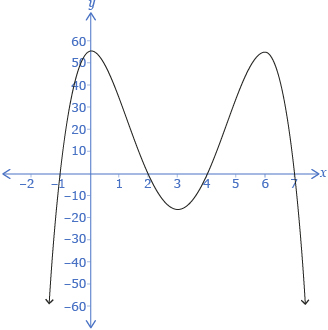Explore
In Try This 1 you may have concluded that in order to solve polynomial equations, one side of the equal sign must be zero. When one side of the equal sign is zero, the zero-product property can be used. (If the product of 2 or more numbers is zero, then one or more of the numbers must be zero.)
Based on this information, Isabel decided to subtract 45 from both sides of her equation to get an equivalent equation.

In order to use the zero-product property, −x4 + 12x3 − 37x2 + 6x + 56 needs to be factored.
How to Factor Polynomials
Step 1: For any polynomial, f(x)
- the remainder theorem tells you that f(a) = the remainder when f(x) is divided by x − a
- the factor theorem tells you to look for values of a such that f(a) = 0
- the integral zero theorem tells you to try factors of the constant term of f(x) for values of a
Step 2: Use the factor theorem to determine one factor of f(x).
Step 3: Perform polynomial division to determine a second factor.
Step 4: This equivalent factored form can be written as f(x) = (x− a)Q(x) + R, where Q(x) is the quotient and R is the remainder.
Step 5: Repeat until all factors have been identified.
In Lesson 1 you learned that the x-intercepts of a polynomial’s graph correspond to the polynomial’s factors. You used the factors to determine the x-intercepts. You can also use this process in reverse: use the x-intercepts to determine potential factors.
Here is the graph of the function f(x) = −x4 + 12x3 − 37x2 + 6x + 56.

Share 2
With a partner or in a group, discuss why f(x) = −x4 + 12x3 − 37x2 + 6x + 56 was graphed instead of p(x) = −x4 + 12x3 − 37x2 + 6x + 101.
![]() If required, save a record of your discussion in your course folder.
If required, save a record of your discussion in your course folder.